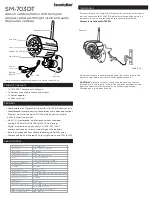
- 1 -
FEATURES
•
Advanced microcontroller
with Digital Signal Process-
ing (DSP)
•
Precise 160
o
protected and
160
o
excluded zones
•
Dual microphones with
time-of-arrival (TOA)
processing
•
Continuous self-test
•
No adjustments
•
No minimum range
•
Remote Test Mode activation
with FG-701 simulator
•
End-of-line / spare terminals
WIRING
(Continued)
Glass-Break Detector
Model
FG-1025Z
INSTALLATION
INSTRUCTIONS
•
Cover and wall tamper
•
Selectable Alarm Memory
•
LED enable
•
8 - 14 VDC operation
•
Energized Form C relay
•
PCB and housing designed
to protect against ESD and
mechanical damage
•
Watchdog for microcontroller
•
Green event LED lights when
sounds are processed
•
Dedicated trouble output
•
Selectable Command Input
or Remote LED Enable
Figure 2b
Wiring for a
N.O. loop, no
EOL resistor
Figure 2c
Wiring for a
N.C. loop with
EOL resistor
Figure 2d
Wiring for a
N.O. loop with
EOL resistor
Figure 2
WIRING
Figure 2a
Wiring for a
N.C. loop, no
EOL resistor
PRODUCT DESCRIPTION
The FG-1025Z is a directional glass-break detector. Two
microphones and time-of-arrival processing allow the unit to
provide precisely-defined protected and excluded zones.
For a detailed description of how the FG-1025Z works, refer to
the Technical Information section on page 5.
MOUNTING LOCATION
For the greatest flexibility in aiming the FG-1025Z, mount the unit
on the ceiling. Figure 3 illustrates the protected, excluded and
keepout zones for a ceiling mounted FG-1025Z.
The arrows printed on the intermediate cover (see Figure 1)
indicate the direction of the protected zone. Refer to the
Mounting Guidelines to select an appropriate location, and refer
to the Aiming Guidelines to aim the unit properly. (
If ceiling
mounting is not possible, the unit can be mounted on a wall or post.)
WIRING
1. For surface-wired installation, use optional Wiring Spacer
Plate (model number FG-SP2).
2. Route wire through Wire Entry Hole in the center of the
printed circuit board (PCB), and strip wire ends 1/4" (6.5 mm).
3. Wire the unit as shown, (use 22 - 18 AWG). Reverse polarity
connections will not damage the unit.
4. When wiring is complete, push excess wire back into the
ceiling. (Refer to the Mounting Locations section.)
NOTE: If end-of-line resistors are required, wire as shown in Figures
2c and 2d.
LEDs
Alarm
Form C
125 mA max
25 VDC max
Power
25 mA at
12 VDC
DIP Switch
Terminal
Blocks
Wire
Entry
Hole
Command Input
Active low (0-1.5V);
or Remote LED
Select function
at S2-3
Tamper Switch
Front Microphone
Figure 1
Back
Microphone
Tamper
25 mA max
24 VDC max
Trouble
Output
Open
collector
1K series
resistor
Keepout
Zones
SYSTEMS, Inc.
























